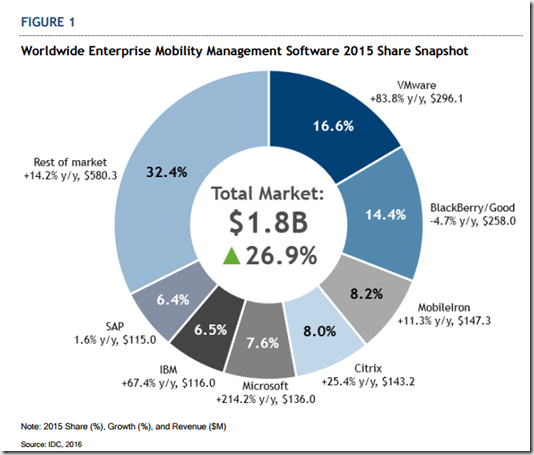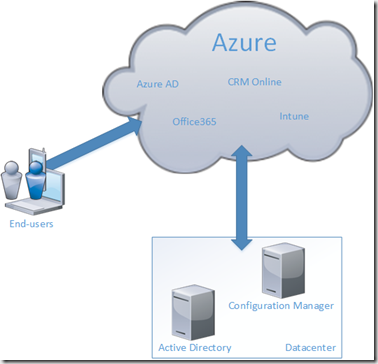Yeah, the subject might be a pretty good indication of what’s coming in this article but no…I have had endless debates of this subject the last couple of years (Yeah years! and you can “insert vendor name” here where most state that they are the best. This article is not to conclude if one is better then the other, but more of things you need to think about when you want to adopt an EMM vendor.
A couple of days ago Gartner posted the EMM Magic Quadrant for 2016

Since 2015 not much has changed especially for Microsoft and VMware. VMware is still the leader in the quadrant, while Microsoft is a bit higher up the chain and moving closer to the leader quadrant. So even though Gartner has it reports which does say alot about Strategy, Execution, Vision and its feature set, how is the market share like ?
IDC also now states the VMware has the biggest marketeshare among the vendors, which also confirms Gartners report that VMware is the market leader in this space. Also VMware has had a growth of <80% the last year.
NOTE: This numbers are from the IDC report and shows stats from 2015 EMM
Now while that is impressive, I am more impressed with the numbers that Microsoft has, even though they are not even among the top 3, they are the only one with <100% growth, they actually have 214% growth (from the last year) which is impressive!
While Microsoft might not have the same capabilities AS VMware, they have a couple of advantages which might allow them to grow quickly in this market….And the easiest way to tell you about those is to show them to you.
Now if we think about it, the largest advantage here is Office365. Many users are already using Office365 and have their Active Directory synced to Azure AD. Microsoft has Office365 apps with custom MAM policies which can of now only be managed from Intune, and also earlier today I saw that CRM online Apps also came with Intune MAM policies. Which allows for a certain vendor lock-in. Now many are also using Configuration Manager today and to get the MDM and EMM capabilities there in most cases you need to integrate with Intune, and some interesting things to know there is that there are alot of LARGE ConfigMgr deployments. Another thing to think about is that Windows 10 comes with Azure AD Join, which allows buisnesses to join their computer to AzureAD and that also supports auto-enrollment to Intune.
It also makes sense for Microsoft to create a good ecosystem for applications for other platforms, because then they can start to include “Intune” as part of the package for MAM policies.
Alot of buisnesses are also looking into EMS (Enterprise Mobility Suite, which gives them Azure AD Premium, RMS, MFA and Intune) Microsoft is heavily invested into the identity piece, to give SSO to other cloud based services, and since Intune is part of the package it makes sense to use it.
And also in another interesting twist, Microsoft announced multiple integrations coming with Citrix under Synergy this year, which allows NetScaler to integrate with the Intune SDK to allow VPN direct access on applications. Which will also give Intune another advantage in the game. So since then investing heavily with Citrix integration it will allow buisnesses which invest heavily into VDI to make Microsoft the more viable option.
Moving forward we will notice that Microsoft will add more features to the “Microsoft-only” space meaning that more and more stuff will only work in a Microsoft cloud cenviroment and that third-parties will be left out.
So while VMware has a better solution, and a larger feature matrix, I’m guessing Microsoft is going to give them a hard competition in the time moving forward.


